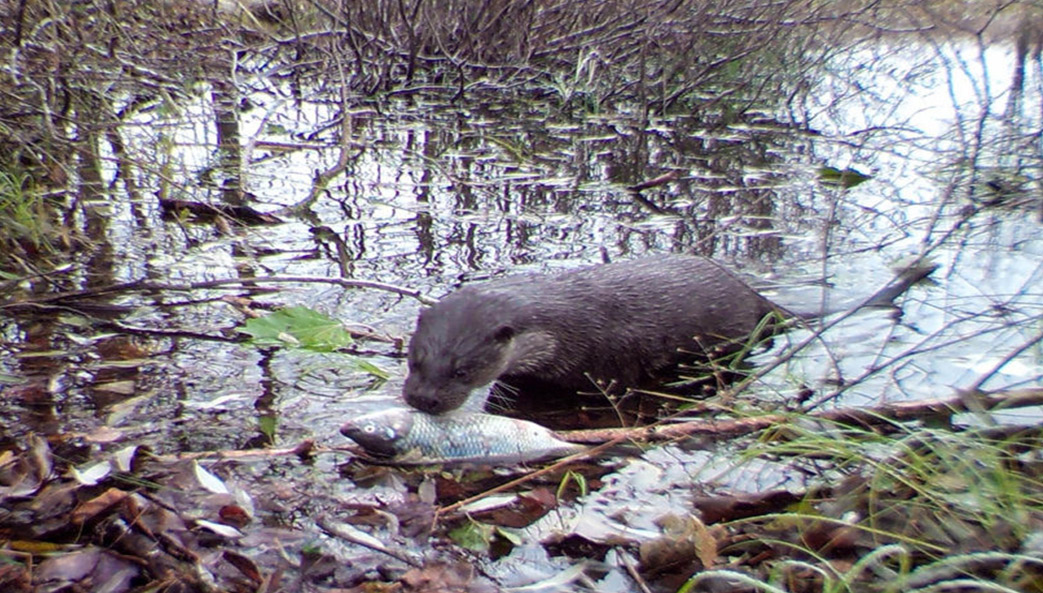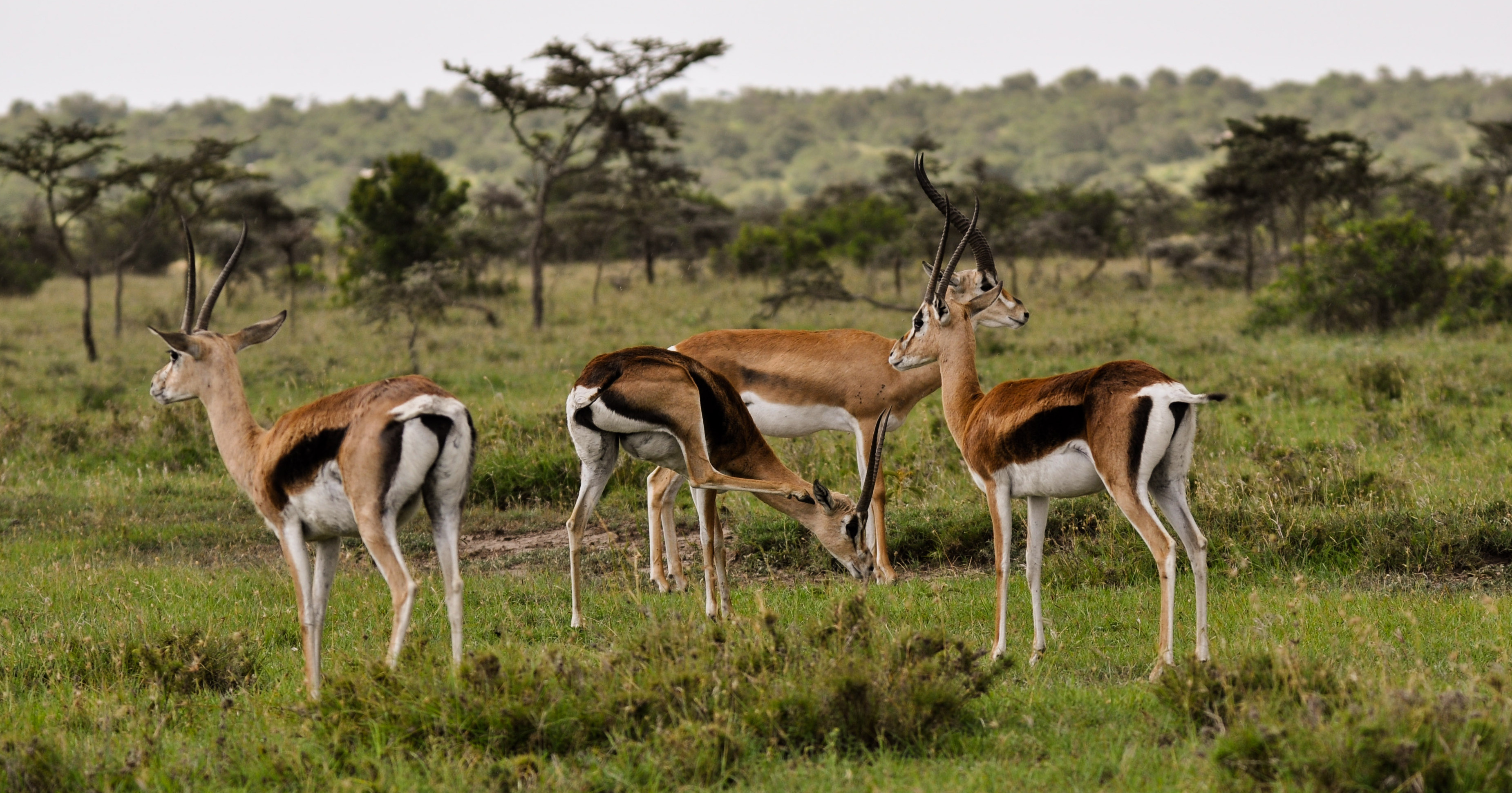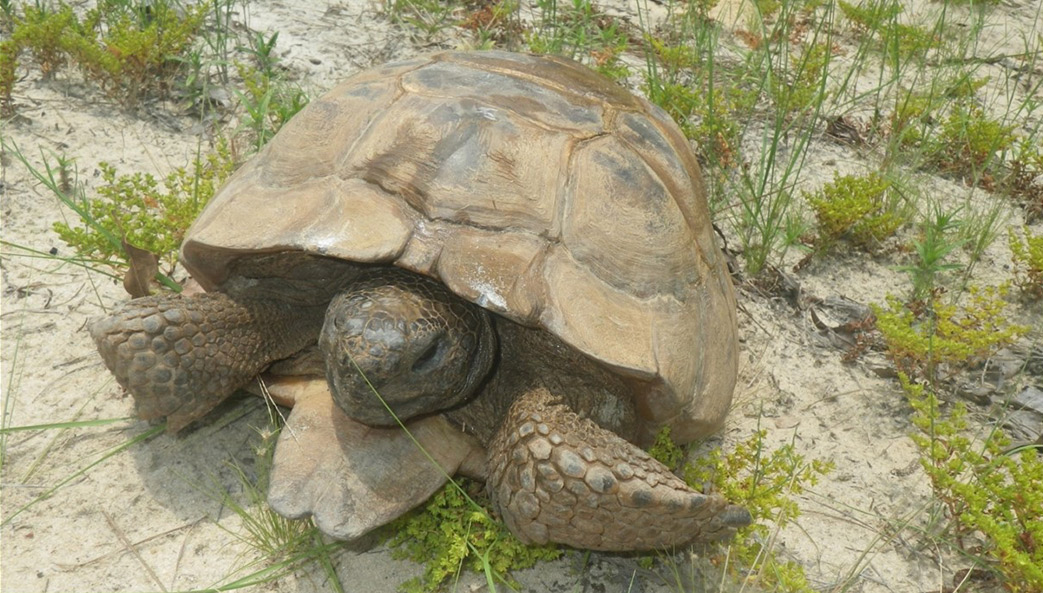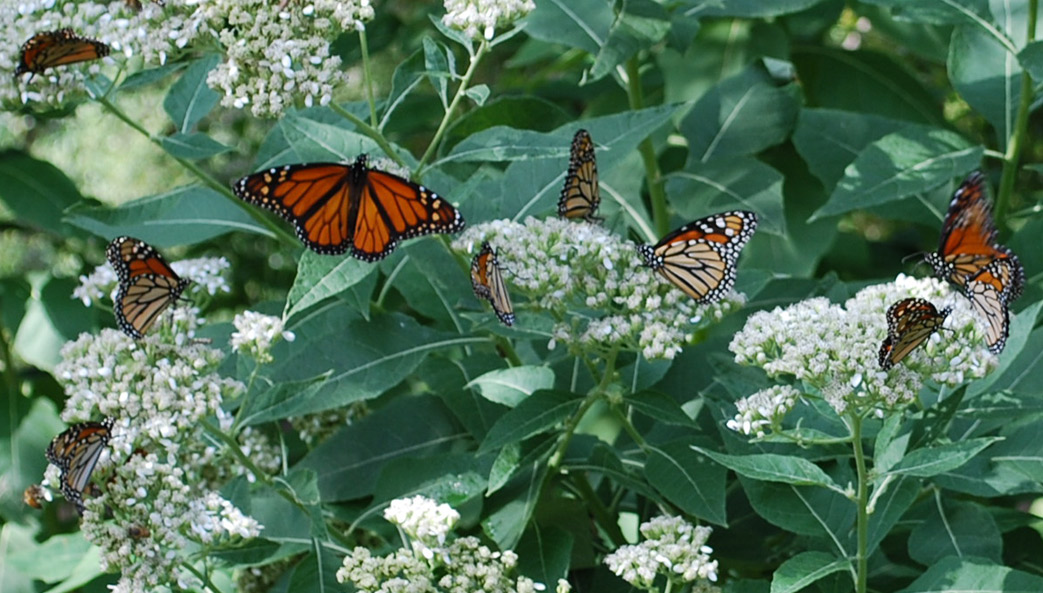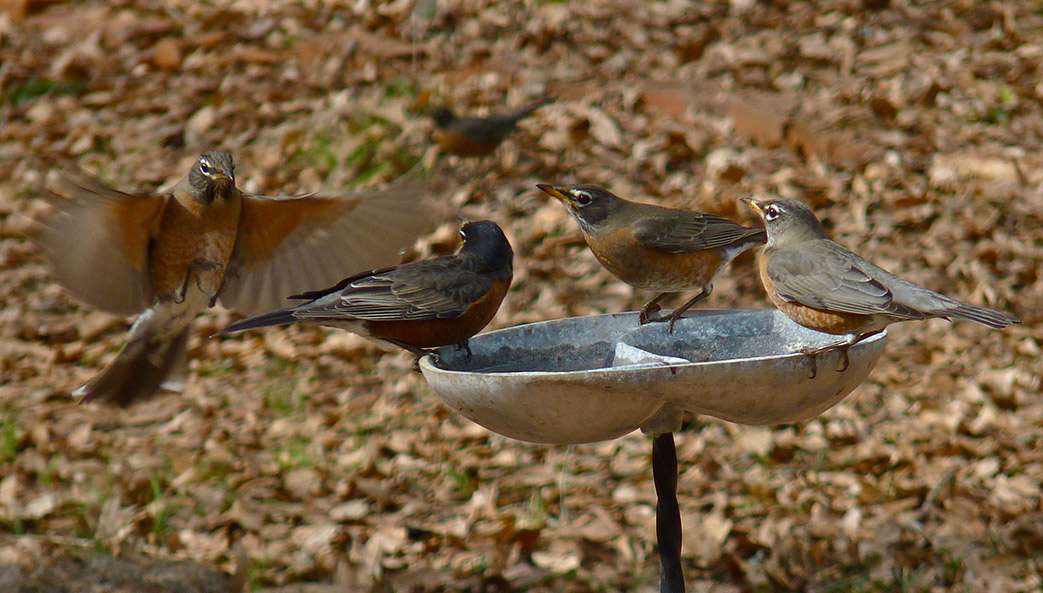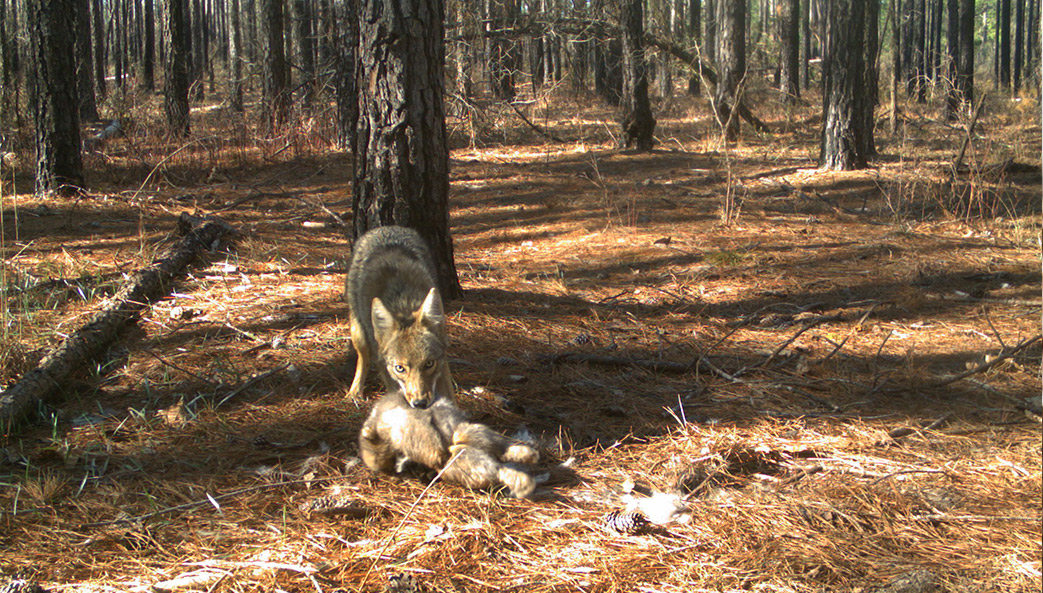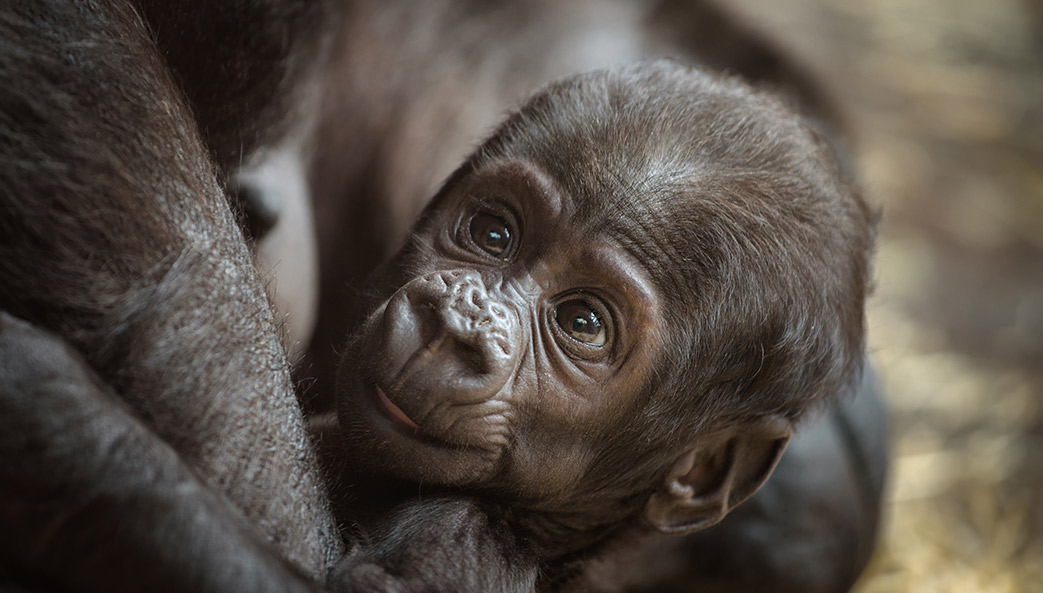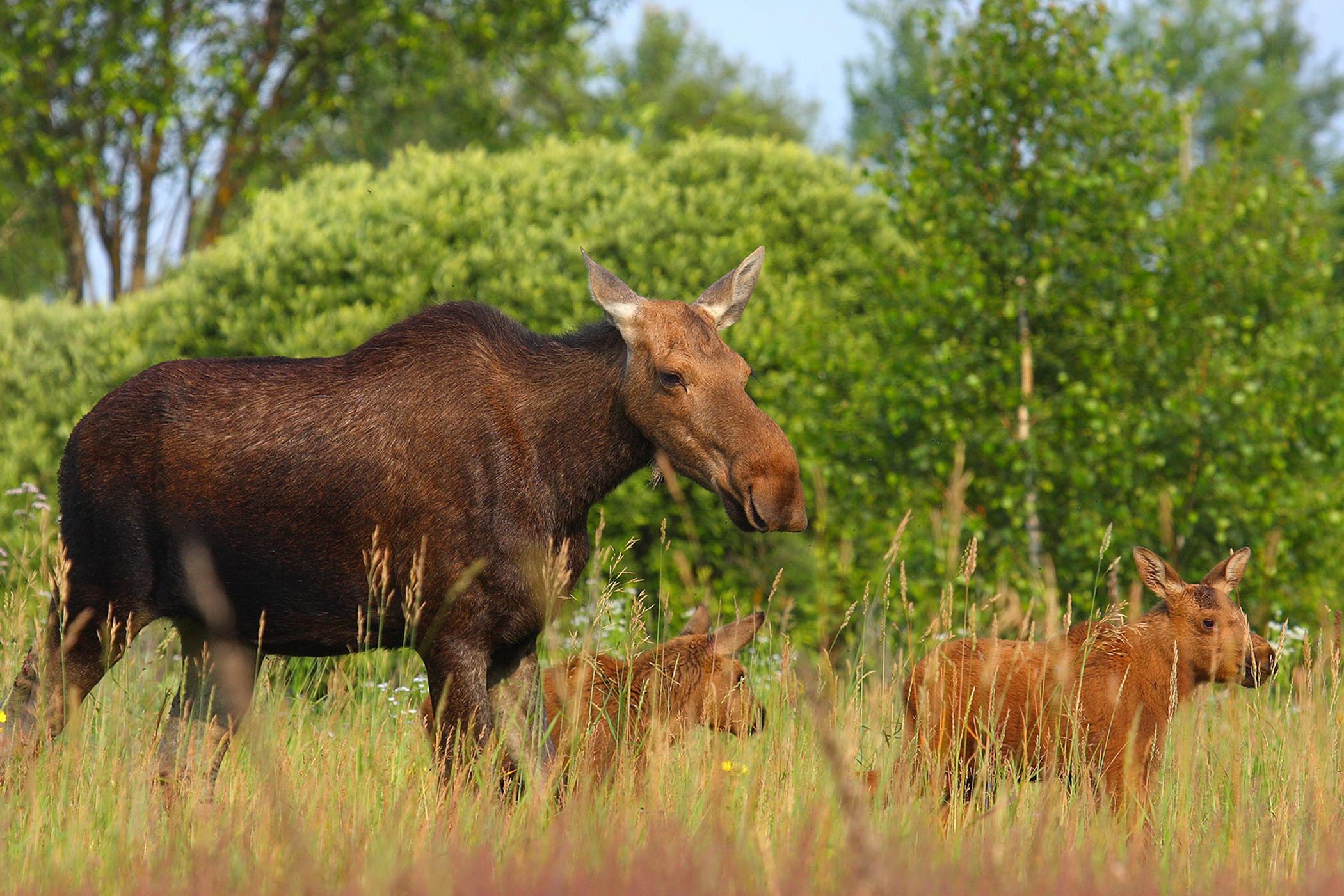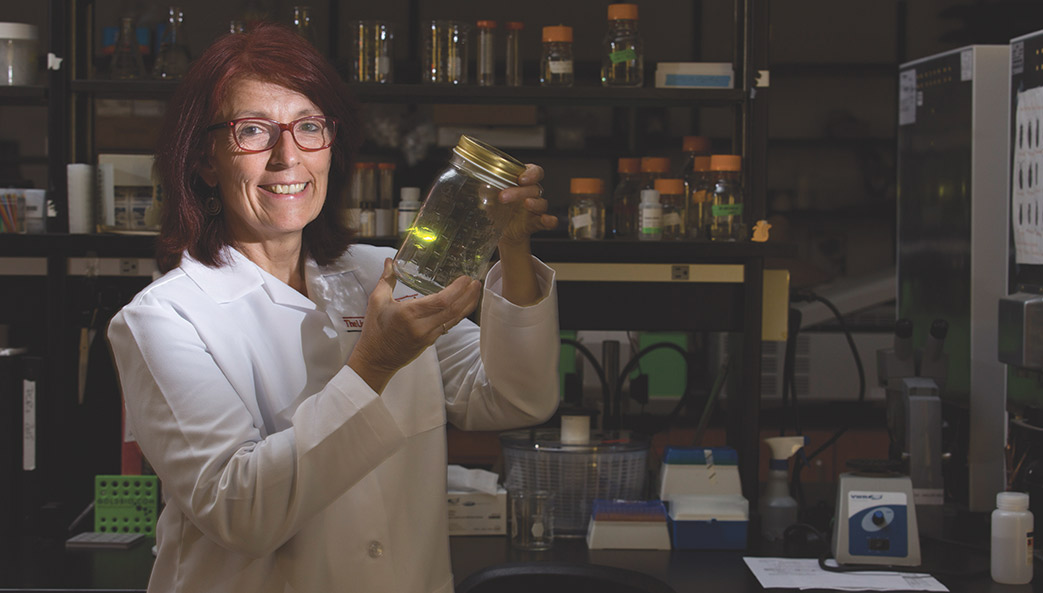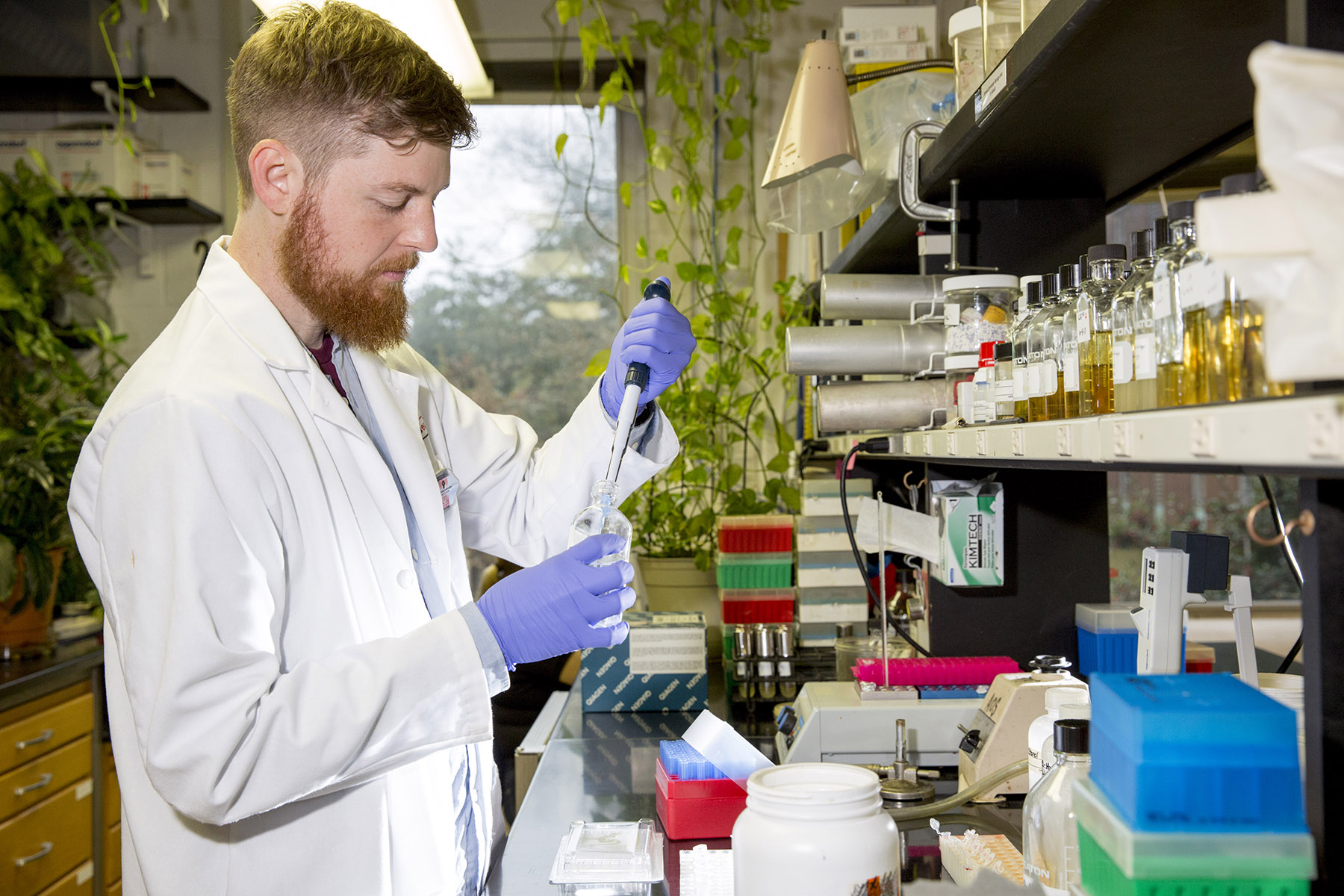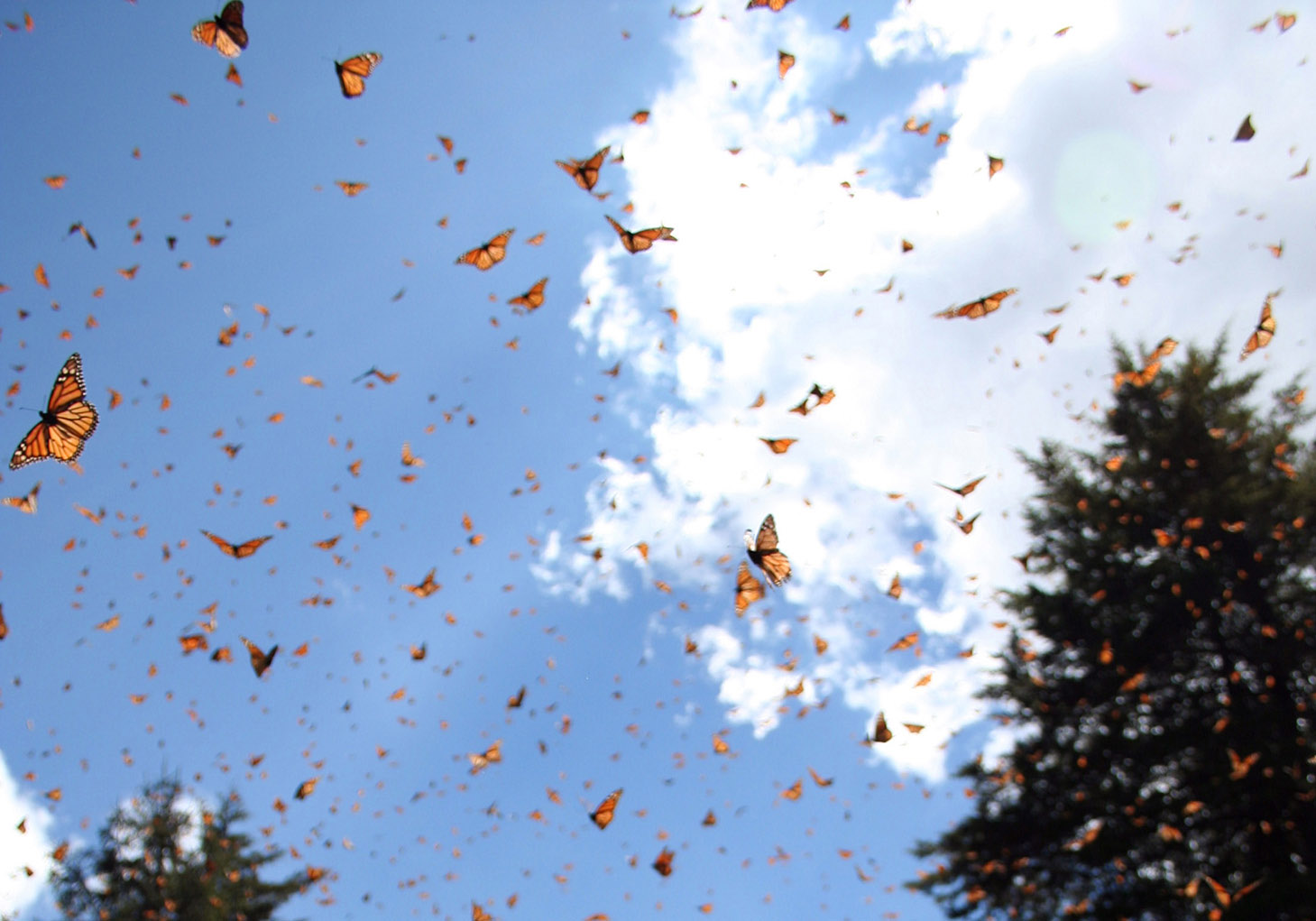Toxic toads can tolerate environmental contaminants
Various amphibians are able to survive environmental contaminants in wetlands
Life returns to Chernobyl
A scavenger study provides additional evidence that wildlife is abundant in the Chernobyl Exclusion Zone
Social animals have more parasite infections but lower infection-related costs
Better protecting them from the negative effects of those parasites
Up on two feet
A wild bearded capuchin monkey is striking an intact piaçava nut with a quartzite stone hammer. (Photo by Barth Wright)
By Alan Flurry
Millions of years ago, before humans became fully bipedal, ancestral hominins used stones to break bones and nuts, probably while standing upright. A new study from the Primate Cognition and Behavior Lab in the department of psychology published today by the Royal Society journal Proceedings B documents how contemporary bearded capuchin monkeys likewise use stones to break nuts:
[B]ecause the fossil record is fragmentary and reconstructing behavior from fossils is difficult, changes in the motor control strategies that accompanied the transition from occasional to obligate bipedalism remain unknown. Among contemporary nonhuman primates, bearded capuchin monkeys spontaneously use stones as hammers to break nuts. These monkeys adopt a bipedal stance while using percussive tools and thus provide a unique reference point to clarify one aspect of the transition from occasional to obligate bipedalism, which is, maintaining bipedal stance while handling massive objects.
“We show that these monkeys move segments of the body synergistically to stabilize the trajectory of large hammer stones (> 50% of their body mass) in bipedal stance rather than controlling the segments individually,” said lead author Madhur Mangalam. “As fossils do not preserve movement strategies, our findings provide insight into an unknown facet of hominin evolution. Synergies like those evident in capuchin monkeys may have accompanied the evolution of bipedality in ancestral hominins.”
Mangalam defended Ph.D. thesis in August under Professor Dorothy M. Fragaszy in the Behavior and Brain Sciences Program at the department of psychology. Fragaszy is Co-Director of the EthoCebus Project, a project concerning the behavior and ecology of wild bearded capuchin monkeys (Sapajus libidinosus) in Piauí, Brazil, living in cerrado habitat (open woodland), and co-author on the new paper. The Primate Cognition and Behavior Laboratory has long been engaged in important research and publishing findings related the evolution of behavior. That great work also includes training bright young researchers like Mangalam. Congratulations to the group on this new publication.
Alligators and timing shed light on reproductive disorders
Timing of exposure is key in how contaminants affect the reproductive system
Where have all the turtles gone, and why does it matter?
New research illuminates the global status of turtles and their ecological roles
Researchers are giving tortoises a ‘head start’
Raising gopher tortoises in captivity may boost wild populations
Migrating monarchs facing increased parasite risks
Migrating monarch butterflies that mix with year-round residents have higher rates of parasite infection
Addressing the wild pig population
Lack of empirical data has made it challenging to evaluate management of the species
Have parasite, will travel
The research, focused on hooved animals, contradicts scientists’ previous expectations
Vampire bat immunity and infection risk respond to livestock rearing
Activities that bring bats into proximity with livestock and people increase the risk of cross-species transmission of pathogens
Unexpected visitors flock to tortoise burrows
Study underscores the importance of gopher tortoise conservation in the Southeast
Feeding wildlife can influence migration, spread of disease
There are serious consequences when human-provided food resources allow animals to forego migration
Hope for pollinators
The number of flowering plants has the greatest influence on butterfly abundance and diversity
Guess who’s coming to dinner: Exploring the factors that influence wildlife scavenging
Time of year has the most visible impact on scavenging efficiency
Why did the terrapin cross the road?
The ticking of a diamondback terrapin’s biological clock can lead to her death—unless she runs into a barrier, according to new research by UGA scientists.
Nearly all terrapin fatalities are caused when adult females looking for a place to lay their eggs wander into traffic, but creating artificial barriers can significantly reduce these deaths. The study found that a barrier erected along part of the Jekyll Island Causeway could keep nearly 58 percent of diamondback terrapins off that section of the road.
“Thousands of terrapins are struck each year on high-traffic roads in New Jersey, Maryland, Georgia and elsewhere,” said Brian Crawford, a postdoctoral researcher in the Warnell School of Forestry and Natural Resources. “It’s a chronic threat to populations, but it’s also an issue for people. Anytime you have that much wildlife on roads, you have to consider the safety of motorists.”
Nesting females seek areas above high tide lines, and that’s where roads are, Crawford said. The summer nesting season—May through July—brings hundreds of terrapins onto causeways near Jekyll, St. Simons and Tybee islands in Georgia. These vacation months also bring peak traffic on coastal roads.
In a paper published in Herpetological Conservation and Biology, Crawford and his collaborators say “hybrid barriers” could be key to helping terrapin populations recover on Jekyll Island as well as in other areas where the slow-moving reptiles often have fatal encounters with vehicles.
The barriers serve the terrapins in two ways. Their short fencing prevents female terrapins from getting to the road. In addition, the structure offers boxes that provide attractive nesting habitat and protection from predators.
Researchers tested a section of the Jekyll Island Causeway, which connects the mainland with Jekyll Island and brings more than 3,400 cars every day, peaking during the summer tourist season. This 55 mph road is also the site of between 100 and 400 adult female terrapin deaths each summer.
Using data spanning several years, the researchers monitored the number of terrapins crossing at three causeway “hot spots” for fatalities. Halfway through the study, they constructed a barrier at one hot spot and were able to compare the number of deaths before and after, as well as how turtles fared at the two hot spots with no barriers.
The results were striking. The site with the hybrid barriers had a 57.3 percent reduction in the number of terrapins emerging onto the road. At the two unblocked sites, there was no change.
Diamondback terrapins are native to the coastal tidal marshes of the eastern and southern U.S. and are found as far north as Massachusetts, as far south as the tip of Florida, and as far west as Texas. They are listed as endangered species in some states.
In addition to being hit by vehicles, diamondback terrapin populations have been affected by habitat loss, commercial and recreational crabbing, and increased numbers of raccoons and other predators that raid terrapin nests. If road deaths and nest loss on Jekyll Island aren’t addressed, Crawford said, the terrapin population there could ultimately disappear.
“There are always many threats impacting wildlife simultaneously, and there’s a growing awareness that conservation strategies won’t be successful if they only focus on one thing,” he said. “This study was an example of designing one management device that had multiple benefits to wildlife populations. The barriers were effective, but there’s always more to do.”
This story appeared in the fall 2017 issue of Research Magazine. The original press release is available at http://news.uga.edu/releases/article/hybrid-barriers-can-cut-terrapin-road-deaths-new-uga-study-finds/.
Primatologist helps bring beasts to life
Most moviegoers watching “War for the Planet of the Apes” this summer had no idea that the gorillas sounded authentic because of guidance provided by UGA primatologist Roberta Salmi, who has done extensive research on the vocal communication of western gorillas.
For her Ph.D. dissertation, Salmi spent 18 months in the forest of the Republic of the Congo and collected more than 2,000 recordings of gorillas’ vocalizations.
Gorillas live in small groups, typically one male and a few females with infants. In these relatively cohesive units they “chat” with each other frequently—exchanging eight calls per hour on average, according to Salmi.
“Most of their calls are exchanged during non-aggressive contexts, and comprise soft grunts and grumbles,” she said. “They laugh when playing, they hum when feeding, infants whine and cry, and they call each other when separated.”
Recordings of gorilla sounds are extremely rare, so Salmi’s expertise is in high demand. She provided 40 calls for the 2014 film “Dawn of the Planet of the Apes” and another 40 new calls when the filmmakers got in touch for assistance with this year’s film.
“They wanted help on gorilla behavior, vocal production, individual distinctiveness, effects of age on sounds, postural position during vocalizations,” said Salmi, assistant professor in the Franklin College of Arts and Sciences. “I also gave them some comments on the sounds made by the actors so that they better resemble gorilla vocalizations.”
This brief appeared in the fall 2017 issue of Research Magazine. The original press is available at https://news.uga.edu/uga-primatologist-provides-gorilla-vocals-in-planet-of-the-apes-film/.
Eat or be eaten
Invasive species on Hawaii Island may be especially successful invaders because they are formidable scavengers of carcasses of other animals and after death, a nutrient resource for other invasive scavengers.
Museum on a chip
This fall researchers at UGA’s Georgia Museum of Natural History will help lead an effort to digitize around 2.1 million specimens from the order Lepidoptera—moths and butterflies—and to make that data available to scientists studying climate, natural habitats and agricultural pests.
Holiday indulgences
May 10, 2016
While a week’s vacation may be just the thing to help employees recover from the daily grind, that time off may also lead to an expanding waistline. A researcher at the College of Family and Consumer Sciences found that adults going on a one- to three-week vacation gained an average of nearly 1 pound during their trips.
“That’s a pretty substantial weight gain during such a short period of time,” said Jamie Cooper, associate professor in the Department of Foods and Nutrition.
One of the factors that likely contributed to the weight gain was increased caloric intake, especially from alcohol. The average alcohol consumption among study participants prior to vacation was eight drinks a week. That number went up to 16 per week during vacation, which accounts for a significant increase in calories.
Cooper said that future studies may be able to provide more information by examining overall caloric intake during vacation, and they may also measure the effectiveness of targeted interventions for cutting back on certain foods and drink.
Female flying aces
May 10, 2016
Evidence has been mounting that female monarch butterflies are better at flying and more successful at migration than males, and UGA researchers have now come up with an explanation.
In a study comparing physical traits of female and male monarchs, they found that although female monarchs have smaller wings and smaller flight muscles than males, their wings are thicker and also bear less weight per square inch, making them both sturdier and more efficient in flight.
“Both of these elements would play important roles in determining the outcome of the migration,” said the study’s lead author Andy Davis, research scientist at UGA’s Odum School of Ecology. “Until now, we had no idea why females were better flyers than males, but this study definitely helps to answer that question.”
The female butterflies’ bodies tend to be lighter in relation to their wing size, making their flight more efficient.
“We believe this work will be important for improving scientific understanding of the migratory cycle,” Davis said, “and it will also serve as a reference point for future studies aimed at flight characteristics of monarch butterflies.”
Life after Chernobyl
May 10, 2016
By Vicky L. Sutton-Jackson
In the early morning hours of April 26, 1986, an unexpected power surge at the Chernobyl Nuclear Complex in Soviet Ukraine triggered a catastrophic explosion in one of the plant’s four reactors, which spewed radioactive fallout that blanketed much of the northern hemisphere.
Widely regarded as the worst nuclear accident in history, the Chernobyl disaster forced the evacuation of hundreds of thousands of people who abandoned their homes and businesses in search of safe haven. The Soviet government also created an exclusion zone around the most contaminated areas that, save for a few families who refused to leave, has remained almost completely uninhabited.
Uninhabited, that is, by people. In a study published recently in the journal Current Biology, scientists report that the site looks more like a nature preserve than a nuclear disaster zone.
A team of international researchers, including James Beasley, assistant professor of wildlife ecology at the Savannah River Ecology Laboratory and the Warnell School Forestry and Natural Resources, found that despite the high levels of radiation, the Chernobyl exclusion zone is teeming with moose, roe deer, wild boar and wolves.
This may come as a surprise to many, especially since much of the imagery from Chernobyl depicts a barren wasteland of crumbling buildings, abandoned schoolyards and roadways overrun with vegetation. Indeed, some previous studies in the 1,621-square-mile site showed evidence of major radiation effects and significantly reduced populations of wildlife.
Now, for the first time since the Chernobyl accident, researchers have long-term census data that reveal thriving wildlife populations in the zone.
“Our data are a testament to the resiliency of wildlife when freed from direct human pressures such as habitat loss, fragmentation and persecution,” said Beasley, a co-author on the study. “The multi-year data clearly show that a multitude of wildlife species are abundant throughout the zone, regardless of the level of radiation contamination.”
But this is no fairytale ending. Radiation still poses a significant threat to both humans and animals.
“This doesn’t mean radiation is good for wildlife, just that the effects of human habitation, including hunting, farming and forestry, are a lot worse,” said Jim Smith, a professor of environmental science at the University of Portsmouth in the U.K. and the team’s coordinator.
The study results show that the number of moose, roe deer, red deer and wild boar living in the zone are similar to numbers in nearby uncontaminated nature reserves.
The census data on wolves in the area indicate they are at least seven times greater in number than those living in the nearby reserves. Aerial census data collected from 1987-1996 reveal rising numbers of moose, roe deer and wild boar in the zone.
Beasley also led another study in which scientists used remote cameras to observe wildlife populations at 94 different sites in the exclusion zone. The motion-activated cameras were attached to trees for seven days at each location, where researchers also placed bait to attract nearby animals.
Sarah Webster, a graduate student at SREL and Warnell, set up the stations approximately 2 miles apart to prevent animals from visiting more than one station during a 24-hour period.
The team documented every species captured on the cameras and the frequency of their visits, specifically focusing on carnivores, Webster said, because of their hierarchy on the food chain.
Carnivores have an increased opportunity to receive contamination. In addition to ingesting it from prey that have foraged on the landscape, they receive it directly from the environment through the soil, water and air.
Beasley and his research team saw 14 species of mammals on the camera footage. The most frequently seen were the gray wolf, wild or Eurasian boar, red fox and raccoon dog, a canid species found in East Asia and Europe. All of these species were sighted at stations close to or within the most highly contaminated areas.
“We didn’t find any evidence to support the idea that populations are suppressed in highly contaminated areas,” Beasley said.
The language of light
May 10, 2016
The firefly is one of nature’s most extraordinary creatures. On warm summer evenings, as the sun dips below the horizon, these small winged beetles take to the air and transform the landscape into a silent symphony of blinking lights, a sight that has captivated human audiences for centuries.
Charming though it may be, the firefly’s light serves a serious purpose. It is a form of communication and the cornerstone of an elaborate courting ritual in which potential mates beckon to one another.
“Just as birds have their songs and colorful plumage, fireflies have their light, which they create by combining oxygen with a chemical called luciferin in their abdomens,” said Kathrin Stanger-Hall, an associate professor of plant biology at the University of Georgia who has spent several years studying the evolution of light signals in North American fireflies. “Their flashes are like a visual Morse code, and I want to understand how they use this code to communicate.”
Along with graduate student Sarah Sander, Stanger-Hall has made a number of discoveries about fireflies that help explain how their unique physical characteristics allow them to speak a language of light.
“The fundamental drive behind all this work is to better understand how animals communicate and what evolutionary forces made them favor one method over another,” Stanger-Hall said. “We’ve already learned so much from studying fireflies and their robust visual language.”
It may sound counterintuitive, but some fireflies do not produce light at all, preferring instead to communicate through pheromones detected through their antennae. Stanger-Hall conducted a study in which she compared the eyes of these lightless fireflies with those that do produce light.
What she found is that lighted species possess considerably larger eyes than their unlighted counterparts, and males generally possess larger eyes than females.
“If you look out in your yard in the evening, most of the fireflies you see in the air are males; females typically remain sedentary on pieces of vegetation,” Stanger-Hall said. “Lighted fireflies—the males in particular—need good eyesight to find the right mate because they may be sharing a habitat with 10 or more different species, each with their own unique flash patterns.”
The differences between these flashes are often subtle, but weekend naturalists can spot them with a little practice. Males belonging to the most common species in North America, for example, drop quickly in altitude and then climb sharply back up, forming the letter J as they flash. This unusual behavior has earned them the name “big dipper firefly.”
You may also have noticed that fireflies produce different hues of light, with some appearing yellow and others a deeper green color. Stanger-Hall and a team of UGA researchers, including Dave Hall, wanted to know the reasons for these differences, so they catalogued more than 7,500 individual firefly flashes from 24 species.
What they found is that the variations in color allow different firefly species to stand out in their respective environments, depending on what time of day they are most active.
“Fireflies that are active earlier in the evening will produce a yellower light to maximize contrast against green vegetation,” said Stanger-Hall. “In comparison, fireflies that are active in darker habitats will produce greener light, which is more visible at night.”
Stanger-Hall is also leading a study that will sequence the genes involved in light production to better understand how fireflies evolved their distinct flashes.
Slithering surprise
May 10, 2016
When researchers at UGA examined the genomes of several snake species, they found something unexpected. Embedded in these reptiles’ genetic codes was DNA that, in most animals, controls the development and growth of limbs—a strange attribute for creatures renowned for their long legless bodies and distinctive slither.
Now, the UGA scientists have found an explanation. In a paper published in the journal Developmental Cell, they report that the genetic tools responsible for limb development also control the formation of external genitalia, which may help explain why snakes have held on to this limb circuitry through the ages.
Snakes weren’t always without legs. They evolved into limbless reptiles over 100 million years ago, said Douglas Menke, assistant professor of genetics at UGA’s Franklin College of Arts and Sciences and senior author of the paper.
“There have been many millions of snake generations since they evolved a legless body, and we would generally expect the DNA associated with limb development to fade away or mutate to do another job, but that doesn’t seem to have happened,” he said. “Naturally, we wanted to know why snakes had retained DNA that they didn’t appear to need.”
In Menke’s and postdoctoral researcher Carlos Infante’s experiments, they examined specific regions of noncoding DNA known as enhancers—“switches” that control the expression of genes, telling them when to turn on or off during embryonic development.
By following patterns of enhancer activity in embryonic limbs and genitalia of mice and lizards, the scientists observed that many of the same enhancers are activated during the formation of these appendages in both sets of species.
Menke and Infante then engineered mice that lacked one of these limb/genital enhancers, and they found defects in the legs and genitalia of the resulting mice. The snake version of this enhancer, however, only functioned during development of genitalia.
“What this meant is that much of the genetic circuitry that controls the development of limbs is also important for the formation of genitalia,” Menke said. “And we think that’s why snakes still have the genetic blueprints for limb development in their genome.”
It is generally accepted among evolutionary biologists that limbs evolved from fins, but phalluses—external genitalia that include the penis and clitoris—are thought to be a much more recent development, he said. And evidence suggests that the genes initially used to grow limbs were later co-opted for the development of a phallus.
“We’re only just beginning to understand the various roles of many of these enhancers,” Menke said. “But what we generally refer to as ‘limb enhancers’ should probably be more broadly categorized as ‘appendage enhancers’ because they clearly perform more than one job.”
The research team had access to the genomes of three snake species: boa constrictor, Burmese python and king cobra. Such comparative genomics research has only recently become possible as the genomes of snakes and other species were sequenced.
In future experiments, the Menke team plans to investigate the extent to which noncoding DNA influences the formation of different genital shapes observed in nature.

Douglas Menke is an assistant professor of genetics at UGA’s Franklin College of Arts and Sciences.
Research links inorganic mercury exposure to damaged cell processes
By Molly Berg
University of Georgia research has found that inorganic mercury, which was previously thought to be a less harmful form of the toxic metal, is very damaging to key cell processes.
This study is the first to compare the effects of inorganic and organic mercury compounds at the biochemical, physiological and proteomic levels in any model organism, according to the study’s lead author Stephen LaVoie, a microbiology doctoral student. Published in December in the Journal of Biological Inorganic Chemistry, the research looked at how inorganic and organic mercury affected specific molecular processes.
Inorganic mercury from the ore cinnabar was used for centuries against infections; in modern times, humans synthesized organic mercurials as antimicrobials, such as merthiolate.
“Today, most human exposure to inorganic mercury is from dental fillings, and organic mercury exposure is from methylmercury in fish,” said study co-author Anne Summers, a microbiology professor in the Franklin College of Arts and Sciences.
Organic mercury exposure is associated with neurological disease, LaVoie explained, whereas inorganic mercury is known to cause neurological, kidney and autoimmune diseases. However, the molecular basis for their distinct toxicity profiles was not understood.
Owing to concern about fish consumption, most research has emphasized organic mercury, assuming it was more toxic, LaVoie said. But comparing them on key cellular processes, he found that inorganic mercury “caused more damage at lower concentrations than organic mercury.”
For his study, LaVoie used a common lab strain of E. coli bacteria as a model cellular system. He exposed growing cells to mercury compounds and measured their reactive sulfur called thiols—essential metals and proteins that naturally bind essential metals via amino acid thiols.
“We used a fluorescent probe to detect thiols,” LaVoie said. After mercury exposure the thiols decreased more with inorganic than organic mercury. Inorganic mercury was much more efficient at removing iron from iron-dependent proteins than the best organic mercury compound tested.
“As fellow oxygen-breathing creatures, it’s important to know that inorganic mercury is more potent than organic mercury in disrupting protein-iron centers such as those we have in our own cells, ” Summers said.
“More is being learned about the bacteria in and on our bodies,” LaVoie said. “What we ingest affects them, too, and their health affects our health.”
Future work will examine the mercury resistance genes that many bacteria have and how these genes help spread antibiotic resistance genes.
Co-authors of the paper include Darin M. Cowart, Michael K. Johnson and Robert A. Scott of the University of Georgia, Daphne T. Mapolelo of the University of Botswana, and Benjamin J. Polacco and Susan M. Miller of the University of California, San Francisco.
This work was supported by DOE awards ER64408 and ER65286 to AOS and ER64409 and ER65195 to SMM and NIH award GM62524 to MKJ.
To read the full study, “Organic and inorganic mercurials have distinct effects on cellular thiols, metal homeostasis, and Fe-binding proteins in Escherichia coli,” published online ahead of print, visit http://link.springer.com/article/10.1007%2Fs00775-015-1303-1.
Wing structure helps female monarch butterflies outperform males in flight
By Beth Gavrilles
Evidence has been mounting that female monarch butterflies are better at flying and more successful at migration than males, and researchers from the University of Georgia have now come up with an explanation—but not one they expected.
In the study comparing physical traits of female and male monarchs, they found that although female monarchs have smaller wings and smaller flight muscles than males, their wings are thicker and also bear less weight per square inch, making them both sturdier and more efficient in flight.
“Both of these elements would play important roles in determining the outcome of the migration,” said the study’s lead author Andy Davis, a research scientist in UGA’s Odum School of Ecology. “Until now, we had no idea why females were better flyers than males, but this study definitely helps to answer that question.”
For the study, published recently in the Journal of Insects, Davis and co-author Michael Holden, an undergraduate ecology student, measured the wings and body parts of 47 male and 45 female monarchs, specifically targeting those characteristics that are important for flight, such as the ratio of wing size to body size, the size of flight muscles and wing thickness.
“We expected we’d find that females have bigger flight muscles, but it was the opposite,” said Holden, who will graduate in spring 2016 with a bachelor’s degree in ecology and will document moth species next year through an internship in Costa Rica. “Males had the largest muscles.”
Their analysis revealed, however, that female bodies tend to be lighter in relation to their wing size, meaning their wings have to carry less weight overall. This would make their flight more efficient.
“The way I think about it is that per flap of their wings, females use less energy to move their bodies relative to males,” Holden said.
In addition, the wings of females were significantly thicker than those of males, making them less likely to break or tear during migration.
“Having damaged wings is a death sentence during the migration,” Davis said.
By the end of the study, the researchers had accumulated a substantial data set of flight-related measurements, the first of its kind for monarchs.
“We believe this work will be important for improving scientific understanding of the migratory cycle,” Davis said, “and it will also serve as a reference point for future studies aimed at flight characteristics of monarch butterflies.”
The study on “Measuring Intraspecific Variation in Flight-Related Morphology of Monarch Butterflies (Danaus plexippus): Which Sex Has the Best Flying Gear?” is available online atwww.hindawi.com/journals/insects/2015/591705/.
Research team finds thriving wildlife populations in Chernobyl
By Vicky Sutton-Jackson
A team of international researchers, including James Beasley, assistant professor of wildlife ecology at the University of Georgia Savannah River Ecology Laboratory and the Warnell School Forestry and Natural Resources, has discovered abundant populations of wildlife at Chernobyl, the site of the 1986 nuclear accident that released radioactive particles into the environment and forced a massive evacuation of the human population.
In the current issue of the journal Current Biology, the researchers report the site looks more like a nature preserve than a disaster zone—abundant with moose, roe deer, wild boar and wolves—nearly 30 years after the world’s largest nuclear accident.
Previous studies in the 1,621-square-mile Chernobyl Exclusion Zone showed evidence of major radiation effects and significantly reduced populations of wildlife. For the first time since the Chernobyl accident, researchers have long-term census data that reveal thriving wildlife populations in the zone.
“Our data are a testament to the resiliency of wildlife when freed from direct human pressures such as habitat loss, fragmentation and persecution,” said Beasley, a co-author on the study. “The multi-year data clearly show that a multitude of wildlife species are abundant throughout the zone, regardless of the level of radiation contamination.”
“This doesn’t mean radiation is good for wildlife, just that the effects of human habitation, including hunting, farming and forestry, are a lot worse,” said Jim Smith, a professor of environmental science at the University of Portsmouth in the U.K. and the team’s coordinator.
The study results show that the number of moose, roe deer, red deer and wild boar living in the zone are similar to numbers in nearby uncontaminated nature reserves in the region.
The census data on wolves in the area indicate they are seven times greater in number than those living in the nearby reserves. Aerial census data collected from 1987-1996 reveal rising numbers of moose, roe deer and wild boar in the zone.
The study’s lead author, Tatiana Deryabina, a wildlife ecologist at Polessye State Radioecological Reserve in Belarus, has been “working, studying and taking photos of the wonderful wildlife in the Chernobyl area for over 20 years, and I am very pleased our work is reaching an international scientific audience.”
Additional co-authors on the study include Thomas Hinton, Institute of Environmental Radioactivity, Fukushima University, Fukushima, Japan; Sergey Kuchmel, Polessye State Radioecological Reserve, Choiniki, Belarus; Liubov Nagorskaya, Academy of Sciences of Belarus, Mince, Belarus; and Adelaide Lerebours, University of Portsmouth, Portsmouth, U.K.
The study was funded by the National Environmental Research Council, Environmental Agency and Radioactive Waste Management Ltd. It is available online at http://www.cell.com/current-biology/fulltext/S0960-9822(15)00988-4.




